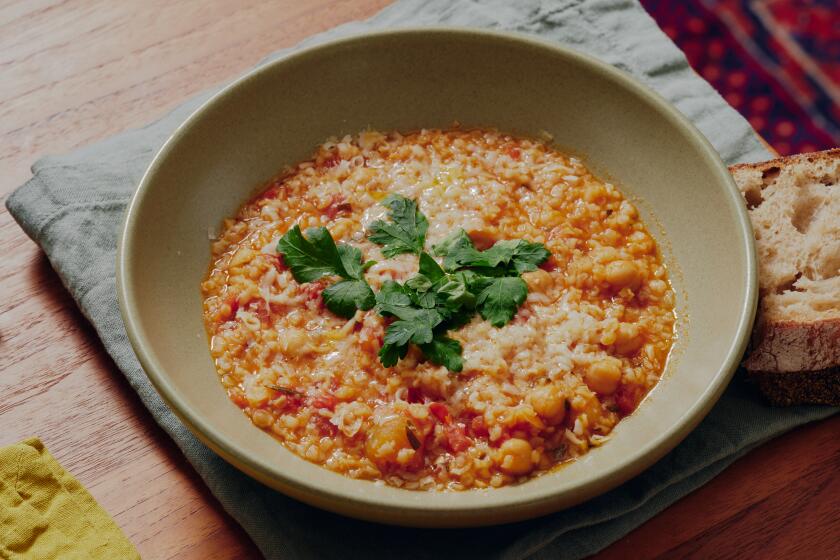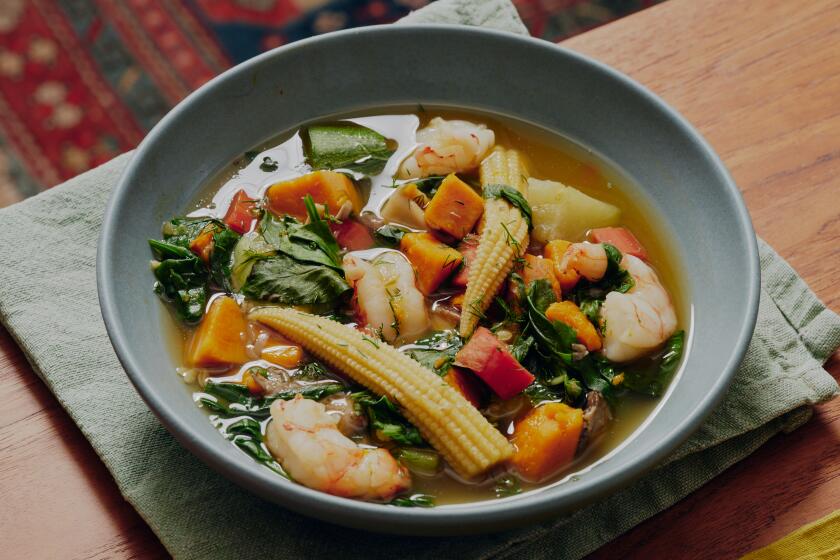Beef stew with chayotes
- Share via
Like many frequent cooks, I think of menus by season. Like most frazzled moms, I think of simplicity. And so in our home, it is the season of the stew.
True, Southern California winters are so mild as to be confused with springtime, but when the temperature dips below 60 degrees, my firehouse-red cast iron Dutch oven is over a flame bubbling with some kind of stew or homemade soup. Inevitably, for inspiration, I go back to my childhood memories. And then I call my mother -- a whiz at making the one-pot soup meals that last two to three days.
Every culture has its own version of comfort soups. In Mexico, it is puchero, a peasant stew with a variety of vegetables and meat. The origins of puchero come from Spain, with nearly all its former colonies creating their own twist on it. In the Philippines, the stew has chickpeas and is made of beef, while in Argentina it has chorizo and blood sausage. In Mexico, puchero varies from region to region, with campechanos eating it as a pork, beef and hen stew augmented in the end with chopped onion in orange juice, radishes with chiles and cilantro. Oaxaquenos add chickpeas and indigenous herbs.
The one common characteristic is that you need a giant pot to make it. And after eating it, your body will feel so satiated and happy that you will need to curl up with a blanket on a comfy sofa.
In my family, a puchero always meant chicken, but more important, it meant pampering. A little puchero, like all chicken soups, would cure any cold, right all wrongs in the world and lift my spirits. But my mother’s puchero was embellished with that Mexican mix of flavors, an inheritance of cultures that are the result of so many conquests.
What gave my mom’s puchero its dense flavor was the cabbage (more Eastern European than Mexican) and the whole chicken (skin and bones) that she would toss into the enormous pot. A great cook, my mother knew that adding bones to any soup would make it more flavorful. She never bothered with chopping vegetables into small, Campbell’s soup-sized morsels. Instead, she would throw in a couple of celery stalks, three to four carrots chopped in half, three or four zucchinis, half an onion, a handful of green beans, a few potatoes and corn if available (winter was not the best time for corn).
We would eat this as a meal, with the chicken meat, vegetables and broth, along with accouterments of chopped cilantro, serrano peppers and a bit of lemon juice, with tortillas on the side.
The next day, my mother would inevitably make sopa de fideo with the leftover broth. But every time I eat this noodle soup, I am brought back to my great-aunt’s apartment in Mexico City, to the little nook outside the kitchen where we, the children, would sometimes eat. As Maria Luisa, the longtime and cranky cook, clanged plates and sang to the radio in the kitchen, my brother and I would slurp away quietly at the hot fideo soup, adding banana, avocado and crumbled cotija cheese into the tomato-infused broth.
This is my all-time favorite soup. But strangely, it is also the source of my one and only great childhood accident. When I was 3, a piping hot bowl was placed before me, I tipped it over and it somehow landed on my face, causing significant burns. My mother cried and cried and prayed that I would not be left with scars. My great-aunt fired Maria Luisa on the spot. Fortunately, cooler heads prevailed, and Maria Luisa was never let go (she stayed with my great-aunts until all were well into their 80s) and my face did not scar.
As a testament to how delicious the soup is, I don’t recall the incident; all I remember is the delicious tomato broth, the sweetness of the banana combined with the savory saltiness of the cheese and the buttery avocado dancing in my mouth.
In a large bowl, toss the beef with 1 1/2 teaspoons of salt and 1 teaspoon of pepper, or to taste.
In a large, heavy-bottomed pot, heat the olive oil until hot. Add the beef (just enough that it fits in a single layer -- this may need to be done in batches) and sear until browned on all sides, 6 to 8 minutes. Add the coarsely chopped onion and cook, stirring frequently, until the onion is softened and lightly colored, about 6 minutes. Add the brandy and continue to cook, scraping any flavorings from the bottom of the pan.
Stir in the water and beef bones and bring the liquid to a boil. Add the bouillon cubes. Loosely cover the pot and gently simmer for 1 hour.
Stir in the carrots, chayote, zucchini, corn and green beans, and continue to cook until the beef is fork tender, about 1 more hour. The vegetables will be extremely soft.
Taste the stew again, and adjust the seasonings, then ladle the stew into a large soup bowl for serving. Place the minced onion, habanero, cilantro and radishes in small bowls alongside the stew for serving.
Get our Cooking newsletter.
Your roundup of inspiring recipes and kitchen tricks.
You may occasionally receive promotional content from the Los Angeles Times.















